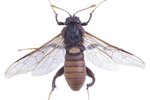
Several species of sphinx moths, Sphingidae family, are ecologically important because they pollinate several types of flowers and plants. These large moths are also known as hawk moths and, on occasion, hummingbird moths. The larvae of some species are much better known than the adults, as they can quickly damage tomato plants.
Adults
Adult sphinx moths are medium to large moths. The tomato hornworm adult has a wingspan of approximately 4 to 5 inches; the whitelined sphinx adult has a wingspan of 2 1/2 to 3 1/2 inches. These moths are sometimes referred to as hummingbird moths due to the way they hover in midair to feed, and flutter from flower to flower, much like a hummingbird. A characteristic of sphinx moths is a thick body with elongated, narrow wings. Adults typically emerge in mid-spring and deposit their eggs while hovering, typically on the underside of the leaves of their host plants.
Larvae
While the adults are important pollinators for many different types of plants, the larvae are caterpillars that eat the green matter of host plants. They're typically not a major concern and damage is rarely serious, although a few species can cause considerable damage to garden and agricultural crops. The larvae of sphinx moths are known as hornworms due to their characteristic dorsal horn. Tomato and tobacco hornworms cause damage to tomato plants and tobacco, along with other members of the nightshade family. Larval development takes anywhere from two to five weeks.
Pupae
In most cases the larvae move underground to finish pupation, although some spin very weak silk cocoons while development continues. Depending on the species and conditions, pupation can last for several months. During the pupal stage, the moths are a hard, brown cylindrical shape. During summer, pupation can last only two weeks, although larvae that start the pupal stage in autumn will overwinter and emerge as adults in spring.
Other Information
While it's not completely known where the common name "sphinx" came from, it could have arisen because of the behavior of threatened larvae. They raise their heads and thoraxes up in a pose that superficially resembles Egyptian sphinxes. Most of the adults prefer tubular-shaped flowers, although most species don't typically have solid preferences for larval host plants.
References
Photo Credits
-
Brand X Pictures/Brand X Pictures/Getty Images
Writer Bio
With a professional background in gardening, landscapes, pests and natural ecosystems, Jasey Kelly has been sharing her knowledge through writing since 2009 and has served as an expert writer in these fields. Kelly's background also includes childcare, and animal rescue and care.




